 Breda municipality / Gemeente Breda (NB) 2/2 After the fortifications around the old town were demolished in 1870-1877, Breda expanded its urban territory with several new neighbourhoods on the sites of the fortifications. After 1927 the city grew considerably outside its former limits, when several surrounding villages were annexed. This page shows a few churches in Breda outside the centre, including these former villages. Nadat de vestingwerken rond de oude stad werden afgebroken in 1870-1877, breidde Breda haar bebouwde grondgebied uit met een aantal nieuwe buurten op de plaats van de vestingwerken. Vanaf 1927 groeide de stad aanzienlijk buiten zijn vroegere grenzen, toen een aantal omliggende dorpen werden geannexeerd. Deze pagina toont een aantal kerken in Breda buiten het centrum, met inbegrip van deze voormalige dorpen. |
Breda outside the moats
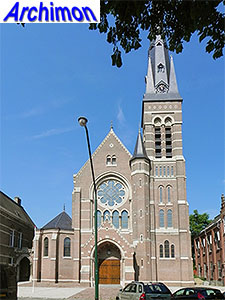 The Heilig-Hartkerk was designed by P.J. van Genk in his usual typical Neo-Gothic style and built in 1900-1901 in a new neighbourhood just to the south of the centre. In 1930-1931 it was extended with a transept and a new choir by J. Stuyt. The church was threatened with demolition for many years after it was closed in 1985, but now its future seems to be secure. Location: Baronielaan 24 De Heilig-Hartkerk werd ontworpen door P.J. van Genk in zijn gebruikelijke herkenbare neogotische stijl en gebouwd in 1900-1901. In 1930-1931 werden een transept en een nieuw koor toegevoegd naar ontwerp van J. Stuyt. De kerk werd na de sluiting in 1985 lange tijd bedreigd met sloop maar lijkt nu veilig te zijn. Locatie: Baronielaan 24 |
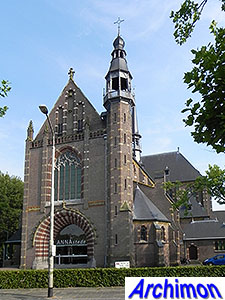 Also just outside the centre, but to its western side, is the former St. Anna. This Neo-Gothic building was designed by J.Th.J. Cuypers and J. Stuyt and built in 1905. Location: Haagweg 1 Net buiten het centrum staat de voormalige St. Anna. Dit neogotische gebouw werd ontworpen door J.Th.J. Cuypers en J. Stuyt en werd gebouwd in 1905. Locatie: Haagweg 1 |
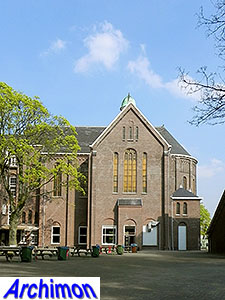 St. Franciscus was the name of a monastery with a school for teachers which existed at this location from 1917 until 1965, although the complex is still a school. Much of the complex was designed by J. van Groenendael, including the Neo-Romanesque chapel which was added in 1923. Location: Dr. Jan Ingen Houszplein 2 St. Franciscus was de naam van een klooster met kweekschool dat op deze locatie stond van 1917 tot 1965, hoewel in het complex nog steeds een school is gehuisvest. Een groot deel van het complex werd ontworpen door J. van Groenendael, waaronder de neoromaanse kapel die in 1923 werd toegevoegd. Locatie: Dr. Jan Ingen Houszplein 2 |
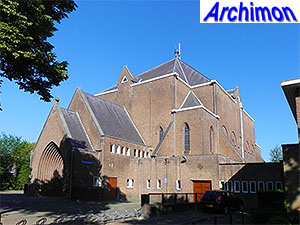 The church of H. Sacrament was designed by J.G.A. van Dongen and built in 1925-1926 in Zandberg, one of the new neighbourhoods outside the former fortifications. Part of the unusual design was a tower which was never built. Location: Zandberglaan 56 De kerk van het H. Sacrament is ontworpen door J.G.A. van Dongen en werd gebouwd in 1925-1926 in Zandberg, een van de eerste nieuwe buurten buiten de voormalige vesting. Onderdeel van het ongebruikelijke ontwerp was een toren die nooit werd gebouwd. Locatie: Zandberglaan 56 |
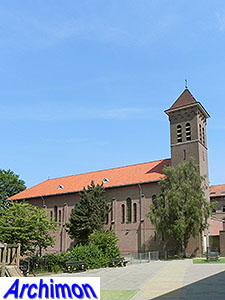 The chapel of the former Benedictine convent is a building in Neo-Romanesque designed by J.A. van Dongen, the uncle of the architect of the adjacent Sacramentskerk, and built in 1926-1927. Location: Generaal Maczekstraat 82 De kapel van het voormalige Benedictinessenklooster is een gebouw in neoromaanse stijl, ontworpen door J.A. van Dongen, de oom van de architect van de naastgelegen Sacramentskerk, en gebouwd in 1926-1927. Locatie: Generaal Maczekstraat 82 |
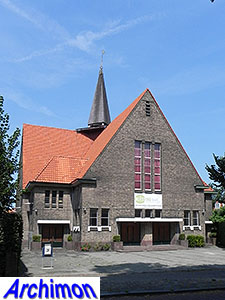 The (Geref.) Zandbergkerk was built in 1933-1934 and is a fairly standard cruciform church in moderate Expressionist style, designed by B.W. Plooij. It's nowadays an Evangelical church. Location: Zandberglaan 31 De (Geref.) Zandbergkerk werd gebouwd in 1933-1934 en is een vrij standaard kruiskerk in een gematigd expressionistische stijl, ontworpen door B.W. Plooij. Het is tegenwoordig een evangelische kerk. Locatie: Zandberglaan 31 |
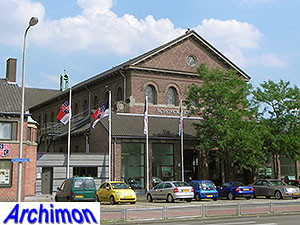 Like many catholic post-World War Two churches, the O.L. Vrouwe van Fatima is in a Traditionalist style influenced by ancient Roman basilicas. It was designed by A.Siebers and W.van Dael and was built in 1949. It's currently an office-building. Location: Fatimastraat 3 Zoals vele katholieke kerken van na de Tweede Werldoorlog, is de O.L. Vrouwe van Fatima gebouwd in een traditionalistische stijl die is beïnvloed door de antieke Romeinse basilieken. De kerk werd ontworpen door A.Siebers and W.van Dael en dateert uit 1949. Het is tegenwoordig een kantoorgebouw. Locatie: Fatimastraat 3 |
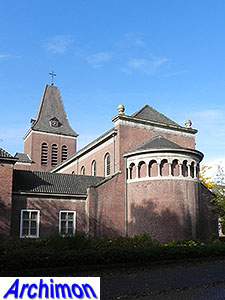 The chapel of the Franciscan convent Maria Mater Dei was built in a Traditionalist style with obvious Romanesque influences. It was built between 1950 and 1952 and was designed by W. Oomen and J. Oomen. Location: Monseigneur Hopmansstraat 2 De kapel van het franciscanessenklooster Maria Mater Dei is gebouwd in een traditionalistische stijl met duidelijke romaanse invloeden. Het werd gebouwd tussen 1950 en 1952 en is ontworpen door W. Oomen en J. Oomen. Locatie: Monseigneur Hopmansstraat 2 |
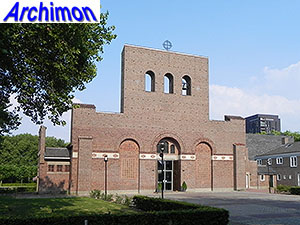 Although M.J. Granpré Molière was the
leading figure in the Delft School, an influential movement for
Traditionalist (church)architecture between 1920 and 1960, he only
designed a few churches himself. This O.L. Vrouw van Altijddurende
Bijstand dates from 1954 and was built in the Heuvelkwartier, a new
neighborhood which was also designed by him. Although M.J. Granpré Molière was the
leading figure in the Delft School, an influential movement for
Traditionalist (church)architecture between 1920 and 1960, he only
designed a few churches himself. This O.L. Vrouw van Altijddurende
Bijstand dates from 1954 and was built in the Heuvelkwartier, a new
neighborhood which was also designed by him. Location: Mgr. Nolensplein 1 Hoewel M.J. Granpré Molière de leidende figuur was in de Delftse School, een invloedrijke beweging voor traditionalistische (kerk)architectuur tussen 1920 en 1960, ontwierp hij zelf slechts een paar kerken. Deze O.L. Vrouw van Altijddurende Bijstand dateert uit 1954 en werd gebouwd in het Heuvelkwartier, een nieuwe wijk die hij ook ontwierp. Locatie: Mgr. Nolensplein 1 |
Teteringen 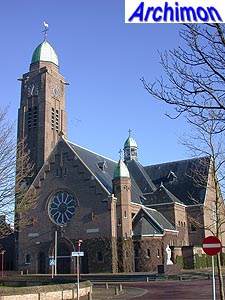 The St. Willibrordus was designed by Jacques van Groenendael and built in 1926-1927. The church has a centralizing ground plan and is in a combination Neo-Romanesque and Expressionist styles. Location: Kerkstraat 1 De St. Willibrordus werd ontworpen door Jacques van Groenendael en is gebouwd in 1926-1927. De kerk heeft een centraliserende plattegrond en is gebouwd in een combinatie van neoromaans en expressionisme. Locatie: Kerkstraat 1 |
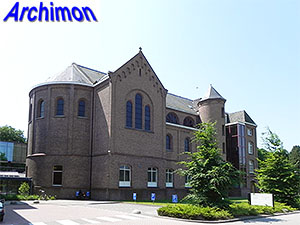 The monastery Missiehuis St. Franciscus Xaverius was founded by exiled German monks in 1916. In 1925-1927 the chapel was built, a compact but tall cruciform basilica in Neo-Romanesque style. Location: Arnold Janssenlaan 1 Missiehuis St. Franciscus Xaverius werd in 1916 gesticht door verbannen Duitse monniken. In 1925-1927 werd de kapel gebouwd, een compacte maar hoge kruisbasiliek in neo-Romaanse stijl. Locatie: Arnold Janssenlaan 1 |
Heusdenhout 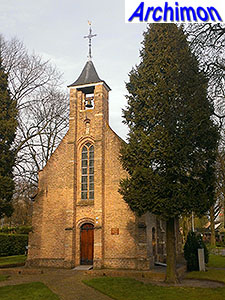 The St. Annakapel is a small single-aisled chapel in Gothic style. It probably dates from the 16th century. After the Reformation it served as a school and a stable. In 1934-1936 it was thoroughly restored by H.W. Valk. Location: Heusdenhoutseweg 34 De St. Annakapel is een kleine eenbeukige kapel in gotische stijl. Waarschijnlijk dateert het gebouw uit de 16e eeuw. Na de Reformatie diende het als school en als stal. In 1934-1936 werd de kapel ingrijpend gerestaureerd door H.W. Valk. Locatie: Heusdenhoutseweg 34 |
Gageldonk 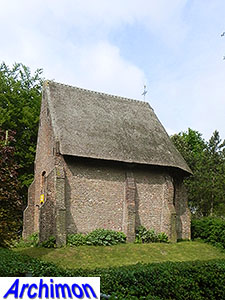 The Kapel van de Heilige Maagd Maria is a small chapel in simple Gothic style, built as the chapel of Gageldonk castle, little else of which remains. The chapel was probably built in the 16th century, possibly earlier. Location: Moerenpad 12 De Kapel van de Heilige Maagd Maria is een kleine kapel in eenvoudige gotische stijl, gebouwd als de kapel van kasteel Gageldonk, waarvan verder weinig resteert. De kapel werd waarschijnlijk gebouwd in de 16e eeuw, mogelijk eerder. Locatie: Moerenpad 12 |
Ginneken 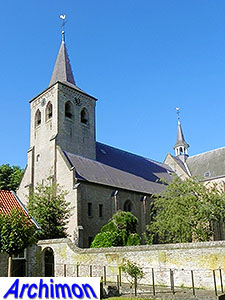 The reformed church of Ginneken is an originally late-Gothic building which was heavily damaged and restored several times, resulting in a combination of styles. The choir and transept are its oldest parts, and date from the 15th century. Location: Duivelsbrugstraat 1 De hervormde kerk van Ginneken is een in oorsprong laat-gotisch gebouw dat meerdere malen zwaar beschadigd en weer gerestaureerd werd, met als gevolg een combinatie van stijlen. Het koor en transept zijn de oudste delen en dateren uit de 15e eeuw. Locatie: Duivelsbrugstraat 1 |
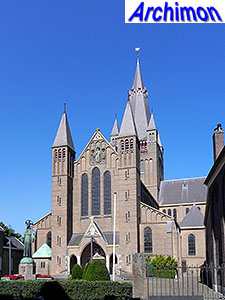 The St. Laurentius is the Roman Catholic church of Ginneken. It was designed by J.Th.J. Cuypers and J. Stuyt and built in 1901-1902. The church was built in a combination of Neo-Romanesque and Neo-Gothic styles, and has a tall tower on the crossing. Location: Ginnekenweg 333 De St. Laurentius is de rooms-katholieke kerk van Ginneken. Het gebouw werd ontworpen door J.Th.J. Cuypers en J. Stuyt en werd gebouwd in 1901-1902. De kerk werd gebouwd in een combinatie van neoromaanse en neogotische stijlen en heeft een hoge toren op de kruising. Locatie: Ginnekenweg 333 |
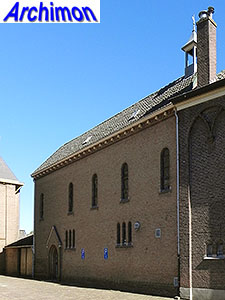 The chapel of the former Franciscan convent Gesticht Pius, later named St. Frans, was built in Neo-Romanesque style in ca. 1900. Its architect is not known. Location: Ginnekenweg 335 De kapel van het voormalige Franciscanesser klooster Gesticht Pius, later genaamd St. Frans, werd gebouwd in neoromaanse stijl in ca. 1900. De architect is niet bekend. Locatie: Ginnekenweg 335 |
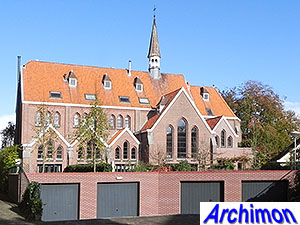 The
St. Laurenskapel was the chapel
of the St. Laurensgesticht hospital, which was built in 1913 and
included a convent. The chapel was at its front side originally
connected to another building. Most parts of the hospital were
demolished after it closed in 1993. The chapel is in late Neo-Gothic
style and was designed by J.A. van Dongen, uncle of J.G.A. van
Dongen. It now houses a number of apartments. The
St. Laurenskapel was the chapel
of the St. Laurensgesticht hospital, which was built in 1913 and
included a convent. The chapel was at its front side originally
connected to another building. Most parts of the hospital were
demolished after it closed in 1993. The chapel is in late Neo-Gothic
style and was designed by J.A. van Dongen, uncle of J.G.A. van
Dongen. It now houses a number of apartments. Location: Laurenspark De St. Laurenskapel was de kapel van het ziekenhuis St. Laurensgesticht, dat werd gebouwd in 1913 en ook een klooster omvatte. De kapel was aan de voorzijde oorspronkelijk verbonden met een ander gebouw. De meeste delen van het ziekenhuis werden afgebroken na de sluiting in 1993. De kapel is in de late neogotische stijl en werd ontworpent door J.A. van Dongen, oom van J.G.A. van Dongen. De kapel bevat nu een aantal appartementen. Locatie: Laurenspark |
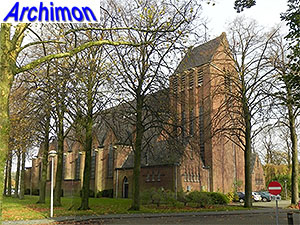 The
Maria Middelares was built in
1933-1934 in an agricultural part of Ginneken which now belongs to
the IJpelaar neighbourhood of Breda. The church is a christocentric
triple-aisled building in a Traditionalistic style with
Expressionist elements, and was designed by J. Hurks. The
Maria Middelares was built in
1933-1934 in an agricultural part of Ginneken which now belongs to
the IJpelaar neighbourhood of Breda. The church is a christocentric
triple-aisled building in a Traditionalistic style with
Expressionist elements, and was designed by J. Hurks. Location: Mariaplein 1 De Maria Middelares is gebouwd in 1933-1934 in een agrarisch deel van Ginneken dat tegenwoordig deel uitmaakt van de Bredase buurt IJpelaar. De kerk is een christocentrisch driebeukig gebouw in een traditionalistische stijl met expressionistische elementen, en is ontworpen door J. Hurks. Locatie: Mariaplein 1 |
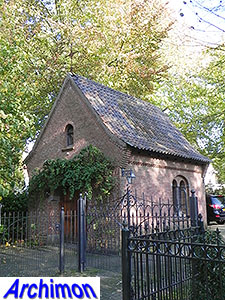 In 1945 this Mariakapel or chapel of O.L.V. van Altijddurende Bijstand was built by commision of F. van Iersel, director of the Kwatta chocolate factory, out of gratitude for the fact that his family survived World War Two. The chapel was designed in Neo-Romanesque style by Th.W.A. Zwegers. Location: Ulvenhoutselaan In 1945 werd deze Mariakapel of kapel van O.L.V. van Altijddurende Bijstand gebouwd in opdracht van F. van Iersel, directeur van de Kwatta chocoladefabriek, uit dankbaarheid voor het feit dat zijn familiede Tweede Wereldoorlog had doorstaan. De kapel werd ontworpen in neoromaanse stijl door Th.W.A. Zwegers. Locatie: Ulvenhoutselaan |
Princenhage 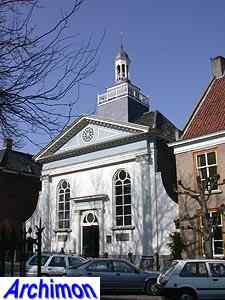 The Neo-Classical reformed church of Princenhage dates from 1819 and was designed by N. Plomp. Location: Dreef 7 De neoclassicistische hervormde kerk van Princenhage dateert uit 1819 en werd ontworpen door N. Plomp. Locatie: Dreef 7 |
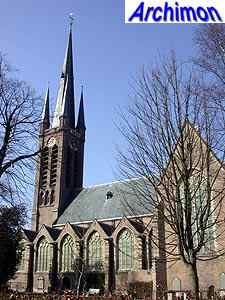 The St. Martinus is the catholic church of Princenhage. It's a Gothic church built in the late-15th and 16th century. The tower was destroyed by fire in 1873 and later restored in neo-Gothic style by P.J.H. Cuypers and J.J. van Langelaar. Location: Haagsemarkt 2 De St. Martinus is de katholieke kerk van Princenhage. Het is een gotische kerk uit de laat-15e en 16e eeuw. De toren werd verwoest door een brand in 1873 en later gerestaureerd in neogotische stijl door P.J.H. Cuypers en J.J. van Langelaar. Locatie: Haagsemarkt 2 |
Lies 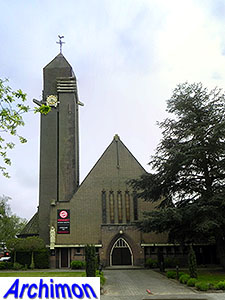 The Pastoor van Arskerk is a single-aisled cruciform church in Expressionist style. It was built in 1929-1930 to a design by J. Hurks. It closed in 2012 and is now a shop. Location: Liesboslaan 293 De Pastoor van Arskerk is een eenbeukige kruiskerk in expressionistische stijl. Ze werd gebouwd in 1929-1930 naar ontwerp van J. Hurks. De kerk werd in 2012 gesloten en is nu een winkel. Locatie: Liesboslaan 293 |
Effen 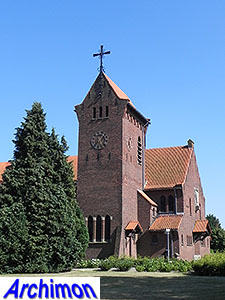 The Moeder Godskerk was built in 1938-1939 to a design by J. Hurks. It's a big, triple-aisled church in Traditionalist style and was built in a period when Effen, formerly a group of Hamlets, was expected to develop into a new urban neighbourhood, which never happened. Location: Effenseweg 3 De Moeder Godskerk werd gebouwd in 1938-1939 naar een ontwerp van J. Hurks. Het is een grote driebeukige kerk in traditionalistische stijl en werd gebouwd in een periode waarin Effen, vroeger een verzameling gehuchten, naar verwachting zou uitgroeien tot een nieuwe stadswijk, hetgeen nooit gebeurde. Locatie: Effenseweg 3 |
De Klokkenberg
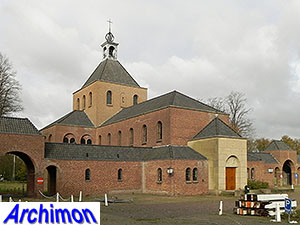 De Klokkenberg is the name of a big complex in the very south of Breda proper, at a remote distance from the city. The complex was built as a sanatorium for tuberculosis patients in 1953. Much of the complex was designed by C.H. de Bever and C.M. van Moorsel, while the chapel in Traditionalist style was probably designed by De Bever alone. Location: Galderseweg 81 De Klokkenberg is de naam van een groot complex in het zuiden van Breda, gelegen op enige afstand van de stad. Het complex is gebouwd als een sanatorium voor tuberculose-patiënten in 1953. Het complex is grotendeels ontworpen door C.H. de Bever en C.M. van Moorsel, terwijl de kapel in traditionalistische stijl waarschijnlijk is ontworpen door alleen De Bever. Locatie: Galderseweg 81 |
Ulvenhout 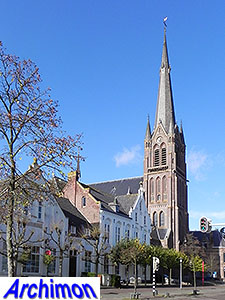 The St. Laurentius is a big cruciform basilica in Neo-Gothic style, built in 1903-1904 to a design by C.F. van Hoof. It replaced a much smaller barn-church from the late-18th century. Location: Dorpsstraat 42 De St. Laurentius is een grote kruisvormige basiliek in neogotische stijl, gebouwd in 1903-1904 naar een ontwerp van C.F. van Hoof. Het verving een veel kleinere schuurkerk uit het einde van de 18e eeuw. Locatie: Dorpsstraat 42 |
Bavel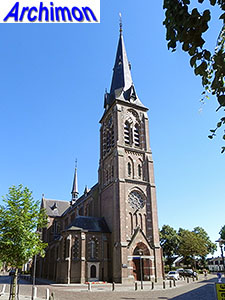
The O.L.V. Hemelvaart is a cruciform basilica in Neo-Gothic style, built in 1886-1887 as a replacement for a smaller 15th-century church. The new church was designed by J.J. van Langelaar. Location: Brigidastraat 1 De O.L.V. Hemelvaart is een kruisvormige basiliek in neogotische stijl, gebouwd in 1886-1887 ter vervanging van een kleinere 15e-eeuwse kerk. De nieuwe kerk werd ontworpen door J.J. van Langelaar. Locatie: Brigidastraat 1 |
|
|